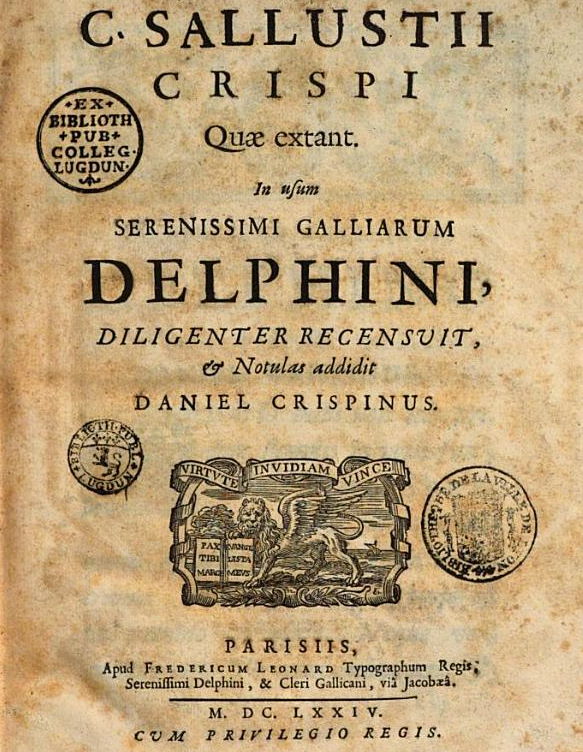What is your favorite classical commentary? What place did it have in your intellectual development? Recently I asked the members of the DCC editorial board to write for the blog about these questions. Here is the response of Terence Tunberg, Professor of Classics at the University of Kentucky, and director of the Conventiculum Latinum Lexintoniense:
When I taught Sallust two years ago, I benefited enormously from a commentary on Sallust’s works that most classicists today would consider obsolete. My students (most of whom couldn’t care less about what is considered obsolete and what is regarded as current practice) enjoyed the commentary even more than I did. Most of them were quite new to reading unadapted Latin texts, and using this commentary seemed to accelerate their appreciation of Latin as Latin. Here is the title, along with place and date of publication:
C. Sallustii Crispi quae ex<s>tant in usum serenissimi Galliarum Delphini diligenter recensuit et notulas addidit Daniel Crispinus (Parisiis apud Fredericum Leonard, 1674)
All of the introductory material and explanatory notes accompanying the text of Sallust in this edition are written in clear and elegant Latin. Moreover, on every page there is a Latin paraphrase of Sallust’s text, which really amounts to a translation of Sallust’s works into a different Latin. This well-written paraphrase/translation admirably fills out the sense of some of Sallust’s more compressed and elliptical phrases. The Latin footnotes (which are written in a very simple style) not only explain grammatical peculiarities and harder constructions, but also provide historical and biographical explanations to clarify Sallust’s text.
While all participants in my Sallust course benefited in many ways from the seventeenth century edition, we all, of course, felt the need to use supplementary material now and then. Historical and cultural information, and some of the textual notes, required updating in light of recent scholarship. Nevertheless, I came away with huge respect for this seventeenth-century edition as a superb pedagogical instrument – which provides all sorts of necessary help, but keeps the reader always in the target language. The students using this edition had many times the exposure to Latin constructions and vocabulary than they would have had, if they were using a recent edition in which the text of Sallust is explained by copious notes in English.
The late seventeenth-century editions of classical texts (both Greek and Latin) printed in Paris, and entitled in/ad usum Delphini, were indeed “for the use of the Dauphin,” namely for the son of the king of France. But the phrase in usum Delphini also appears in later editions which had no connection with the royal house of France.

Jean Clouet, “The Dauphin François, Son of François I.” First half of the 16th c., oil on panel. Royal Museum of Fine Arts, Antwerp.
In such editions this phrase in usum Delphini simply indicates the edition is designed for the younger readers in general, who are still getting used to the reading of the unadapted texts of ancient writers. Such, for example, were the classical texts printed in London in aedibus Valpianis during the early nineteenth century. These British editions also feature detailed explanatory notes written in simple Latin, but these notes are often swollen to such size that there is often room for only a tiny amount of original text on each page. Moreover, by comparison with the 1674 edition of Sallust described above, the Latin paraphrase of the classical author’s text was often vestigial or non-existent.
So, my hat is off to those who produced the original editions in usum Delphini.
Images:Google Books and Wikimedia Commons.

John Piazza has collected links to some of the in usum Delphini texts in .pdf format at Google Books: http://www.johnpiazza.net/adusumdelphini
Vivarium Novum also has a list, with links to PDFs: http://www.vivariumnovum.it/edizioni/index.php/Libri/Classici-latini-in-edizione-monolingue.html.
Updated link: https://vivariumnovum.it/risorse-didattiche/pratica-didattica/classici-latini-edizione-monolingue